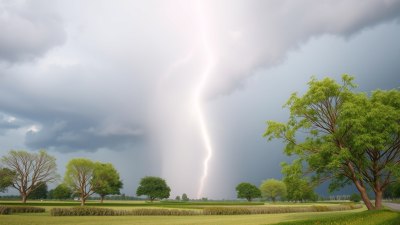The Real Reason Weather Forecasters Smile While Reporting Storms
Discover why weather forecasters maintain a positive demeanor during storm reports and how it impacts viewers.

This image was created with the assistance of DALL·E
When severe storms approach, one might wonder why weather forecasters often maintain a smile while delivering potentially disastrous news. The juxtaposition of a bright smile against the backdrop of looming storms raises questions about professionalism, emotional responses, and viewer engagement. In this article, we’ll delve into the psychological and professional aspects that contribute to this seemingly paradoxical behavior.
The Psychology Behind Smiling
Smiling, as a universal human expression, serves numerous functions in communication. It reflects positivity, comfort, and reassurance. For weather forecasters, smiling while discussing storms can help to convey a sense of control in an otherwise chaotic situation. Understanding the psychology of smiling helps us appreciate why it’s employed in high-stress scenarios like severe weather forecasts.
Facing Viewer Anxiety
Severe weather events can elicit significant anxiety among viewers. People often feel helpless in the face of nature's fury, and this anxiety can escalate quickly during broadcasts about incoming storms. By smiling, forecasters aim to provide comfort and a sense of stability. They want to assure viewers that they have the situation under control and that they will deliver the necessary information in a calm, professional manner.
Building Trust with the Audience
Trust between a forecaster and their audience is critical, especially when dealing with severe weather. A smile can act as a nonverbal cue of authenticity and reliability. By appearing confident and approachable, forecasters can foster trust, which is vital for effective communication. When viewers trust their source of information, they are more likely to heed warnings and take necessary precautions during storms.
Professional Training and Adaptation
Weather forecasters are trained professionals who understand the importance of maintaining composure during broadcasts. Many undergo specific training focused on presentation skills, which includes the effective use of facial expressions. Smiling becomes a tool that helps them both engage the audience and project a sense of confidence, allowing them to effectively relay crucial information.
The Impact of Media Competition
The media landscape is competitive, and weather broadcasts are no exception. Stations often compete for viewer attention, especially during severe weather events. In such cases, a positive demeanor—signaled through smiles—can help a forecaster stand out. This can influence viewer perceptions positively, leading to higher ratings for a station, regardless of the dire circumstances being reported.
Coping Mechanism for Broadcasters
It’s also worth noting that smiling can serve as a coping mechanism for forecasters themselves. Reporting on severe weather can be emotionally taxing, especially when the potential for destruction and loss of life is high. Smiling may help them manage their own stress levels and maintain a positive outlook in challenging circumstances.
Emotional Resilience in Severe Weather Reporting
Emotional resilience is essential for weather professionals. In the face of natural disasters, forecasters often experience internal conflict. They must navigate their personal feelings about the impact of storms while remaining engaged and positive for their audience. Smiling becomes an outward expression of their professional resilience, enabling them to perform their job effectively, despite the weight of the information being communicated.
Engagement through Emotional Connection
Another factor to consider is the emotional connection between forecasters and their audience. Viewers often form attachments to their local meteorologists, seeing them as trusted figures within their communities. Smiling can foster a sense of connection, allowing viewers to feel more at ease during uncertain times. This emotional engagement enables forecasters to convey important warnings more effectively, ensuring that the audience is attentive and responsive to the potential dangers ahead.
Using Humor and Positivity
Some forecasters employ humor or light-heartedness during broadcasts, even amidst reports of severe weather. This approach can lighten the mood and contribute positively to viewer attitudes. While it’s crucial to remain earnest about the potential threat of storms, inserting moments of levity can help to alleviate stress and make the information more digestible. Balancing seriousness with a touch of humor can be an effective strategy for engaging audiences while ensuring they stay informed.
Viewer Expectations and Forecaster Reactions
Viewers have specific expectations regarding how forecasters should deliver severe weather updates. Many expect a confident, reassuring presence during broadcasts. A smile aligns with these expectations, as it projects a sense of optimism and competence. Forecasters, therefore, often adapt their demeanor to meet or exceed viewer expectations, which can naturally result in the smiles seen on screen.
Unpacking the Science of Smiling
The act of smiling isn't just a social nicety; it comes with physiological benefits too. Research has shown that smiling triggers the release of endorphins and serotonin, contributing to feelings of happiness and reducing stress. For forecasters, this means that smiling not only affects viewers but also benefits them personally during high-pressure broadcasts, creating a positive feedback loop for both parties.
The Role of Visual Cues in Communication
In visual communication, body language and facial expressions are just as important as spoken words. Smiling helps to enhance the overall energy and tone of a weather report, making the information more approachable. By incorporating positive physical cues, forecasters can create a more engaging presentation that resonates with viewers during alarming weather conditions.
Discussion on Media Ethics
The use of smiling in serious contexts raises questions regarding media ethics. While it can be used to calm nerves and convey professionalism, it is imperative for forecasters to maintain a balance between optimism and realism. Overly cheerful presentations during dire weather warnings can mislead audiences about the seriousness of the situation. As such, ethical practices dictate that forecasters should remain transparent about the potential dangers while engaging viewers effectively.
In conclusion, the smiles of weather forecasters reporting on storms are not merely superficial gestures. Instead, they embody a complex interplay of psychological tactics, viewer engagement strategies, and professional training. By understanding the reasons behind these smiles, we gain insights into the broader implications of communication during severe weather events. While the storm may be fierce, the forecaster’s smile can serve as a beacon of reassurance, guiding viewers through uncertainty and helping them navigate through turbulent times.











